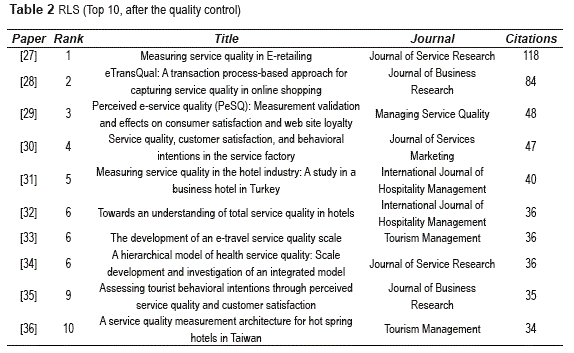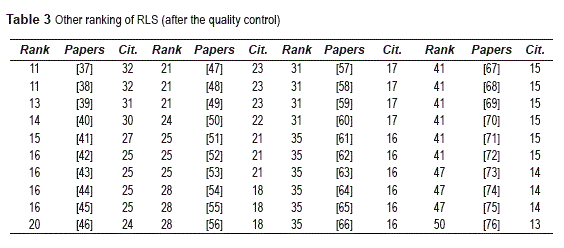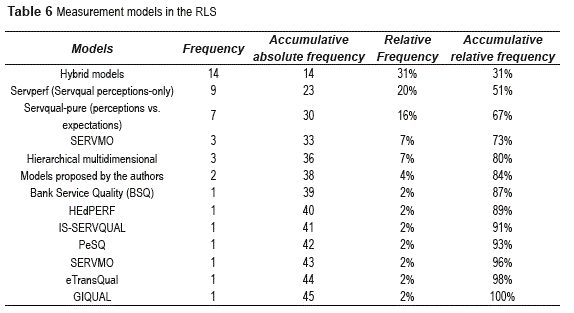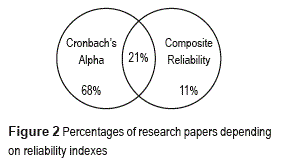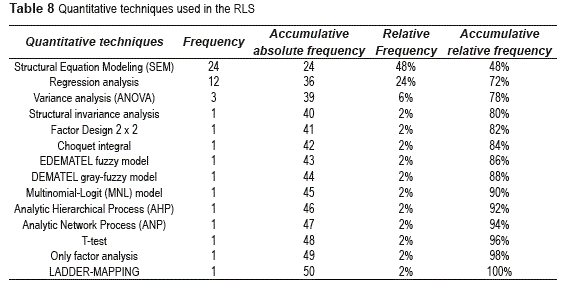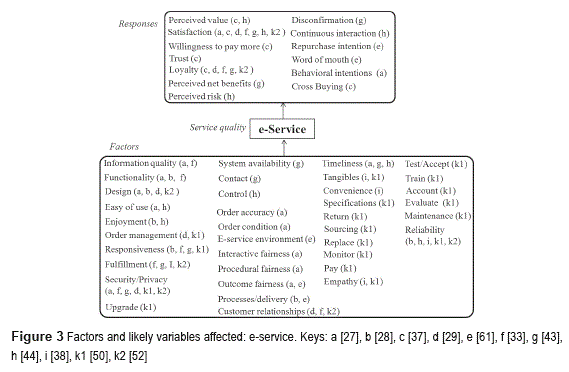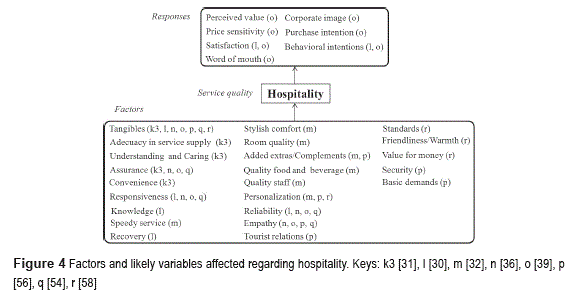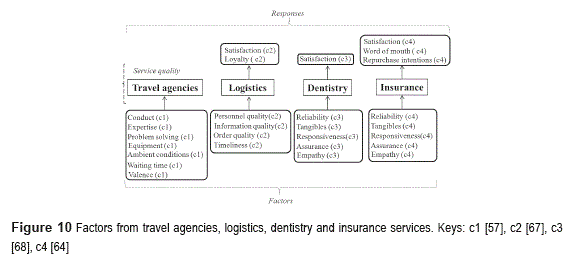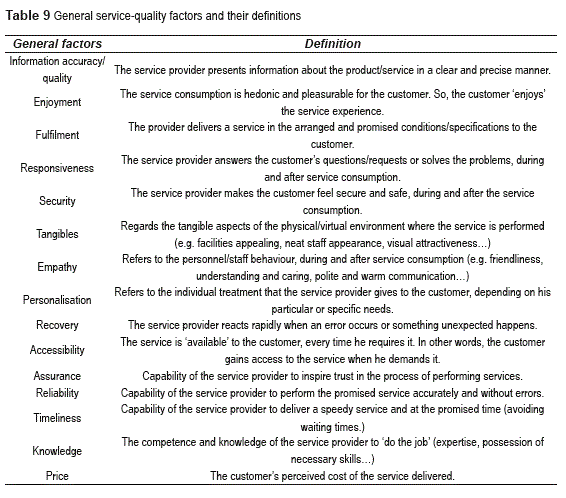Services on Demand
Journal
Article
Indicators
-
 Cited by SciELO
Cited by SciELO -
 Access statistics
Access statistics
Related links
-
 Cited by Google
Cited by Google -
 Similars in
SciELO
Similars in
SciELO -
 Similars in Google
Similars in Google
Share
Revista Facultad de Ingeniería Universidad de Antioquia
Print version ISSN 0120-6230
Rev.fac.ing.univ. Antioquia no.72 Medellín July/Sept. 2014
ARTÍCULO ORIGINAL
What can't be ignored in service quality evaluation: Application contexts, tools and factors
Lo que no debe obviarse al evaluar la calidad del servicio: contextos de aplicación, herramientas y factores
Jorge Pérez Rave* , Leandro Muñoz Giraldo
1Grupo de investigación Gestión de la Calidad, Facultad de Ingeniería, Universidad de Antioquia. Calle 67 No. 53 - 108. Medellín, Colombia. AA. 1226
*Autor de correspondencia: teléfono:: + 57 4 2195575, correo electrónico: jorge.perez@udea.edu.co (J. Pérez)
(Received on November 27, 2012; accepted on June 05, 2014)
Abstract
This paper locates a Relevant Literary Space (RLS) about service quality evaluation, between 2006 and 2011, in order to characterise the following: service typologies, evaluation approaches, measurement models, reliability indexes, scales, quantitative techniques, factors (or quality dimensions) and likely variables affected by them. For this we use a systematic literature review methodology, taking the Scopus database to browse the research papers. The procedure was carried out through the plan-do-check-act cycle. The findings show that the e-service is the most studied typology; the hybrid models are the most used as well as the 7-point Likert scale and Cronbach's Coefficient Alpha (average value of 0.87). Also, the findings show that the majority of the research community applies Structural Equation Modeling. From a holistic interpretation, a general structure of service quality is proposed. This article offers findings about the application of reproducible methods, open-to- scrutiny, and free of inclusion/exclusion biases of studies.
Keywords:Service quality, systematic review, state of the art
Resumen
Este artículo localiza un Espacio Literario Relevante (ELR) sobre la evaluación de la calidad del servicio, entre 2006 y 2011, con el fin de caracterizarlo desde: tipologías de servicio, enfoques de evaluación, modelos de medición, índices de fiabilidad, técnicas cuantitativas, factores (o dimensiones de calidad) y posibles variables afectadas por ellos. Se utilizó una metodología de revisión sistemática, empleando la base de datos Scopus para la localización de los estudios. El procedimiento fue llevado a cabo mediante el ciclo planear-hacer- verificar-actuar. Los resultados mostraron al e-service como la tipología más estudiada; los modelos híbridos, la escala Likert de 7 puntos y el coeficiente Alpha de Cronbach (media 0.87) resultaron ser los de mayor uso. Además, la mayoría de los estudios aplicaron la técnica de Modelos de Ecuaciones Estructurales. Desde una interpretación holística, se propone una estructura general de la calidad del servicio. Este artículo ofrece resultados derivados de métodos reproducibles, abiertos al escrutinio y libres de sesgos de inclusión/ exclusión de estudios.
Keywords:Calidad del servicio, revisión sistemática, estado del arte
Introduction
A study of service quality is one of the most significant elements regarding competitiveness because it allows companies to achieve better performance regarding value-offer design for their customers. Service quality can be understood, generally, as a latent construct that shows how well a service satisfies customer expectations, considering their perceptions only [1], or the gaps between these perceptions and expectations [2] (two different evaluation approaches). For a better understanding of the service quality concept and its complex assessment, the literature has provided reviews or state of the art studies, which are considered a first requirement to inspire the development of primary research works. Current theoretical contributions regarding service quality, although relevant for science and engineering, have gaps that relate to the sort of review upon which they are based: the narrative review. This kind of review may cause biases due to the possible inclusion of studies that are in agreement with the reviewer's viewpoint, and the exclusion of studies that contradict their mental models. In addition, the narrative review is not open-to-scrutiny because its method is not reproducible, and it does not allow identification of all the relevant information sources, among other limitations [3-5].
Apart from the possibility of improving the review methodology, the current service quality literature reveals an opportunity: the low number of review papers about the current situation and future research regarding aspects ofservice quality evaluation can set the stage for novel research agendas. As supporting evidence, consider the following Scopus exploration of service quality which was undertaken on January 8, 2014. Scopus is the biggest database on abstracts and literature reviewed by experts [6-8]. The search algorithm contained the word 'service quality' in the title option solely, in order to retrieve papers for which this subject is the core topic. After running the algorithm, the database found 3.163 documents. With the purpose of retrieving review papers only, the following words were attached to the title option: review, state of the art. Finally, the algorithm used was: TITLE ('service quality') AND TITLE (review OR 'state of the art'). The document recovery shows just 33 review papers.
However, after checking each of these 33 papers, just 15 really matched the review article criteria. The remaining 18 papers were about other subjects such as healthcare processes and quality of service (QoS) or, despite being service quality research papers, were in fact primary research papers instead of review articles (for example, models' development, quality service evaluations, confirmatory factor analysis). In addition, by further filtering the 15 research papers, three were published after 2010: [9-11]. The first one focuses on a review with a systematic approach, limited to the healthcare context (47 papers reviewed; scientific databases: Ebsco, Emerald Insight, ABI- Inform). The second and third research papers are about the banking sector and higher education, respectively. Both of them are narrative reviews. Some the other documents published before or in 2010 are: [12] (Internet environment), [13] (real estate), [14] (healthcare: diabetes; 47 studies) and [15] (alternative industry-specific measurement scales, 30 studies). These last two research papers had a systematic component in the review. This Scopus database exploration led to the view that there is little research production carried out with reproducible, open-to-scrutiny, objective and holistic criteria, about the current situation and future research regarding service quality evaluation.
Because of both gaps in the literature and the significance (and complexity) of the study of service quality, it was considered important to conduct a systematic review, without being constrained to specific economic sectors (service typologies). This is done in order to address the following questions: (P1) which are the most relevant service quality research papers for the academic community, with this subject as core topic, and published between 2006 and 2011?, (P2) How much that identified literary space represents the whole collection of the most relevant research papers in the academic community? (P.3) What characteristics have the service quality studies presented, as a core topic, between 2006 and 2011, regarding: service typologies, evaluation approaches, measurement models, reliability indexes, scales, quantitative techniques for hypothesis testing, factors (or quality dimensions) and likely variables affected by them?
Materials and methods
This paper carried out a systematic review methodology [5], taking the Scopus database to browse the research papers. figure 1 portrays the browse space delimitation. As can be seen, the browse took place on April 23, 2012. This delimitation represents: a) Scopus's criteria for journals (standard peer review, conformity with technical quality standards, abstracts in English and timely edition); b) additional criteria of article (primary studies, central topic, areas of interest, published between 2006-2011, major number of citations - popularity-, and service quality from attitudinal aspects).
The procedure was carried out through the plan-do-check-act cycle. The literary space was delimited to articles and conference papers in order to include only primary studies. In addition, for quality control purposes, a random sample of papers is verified involving the following criteria: 95% reliability level, 5% error estimating for p parameter: the proportion of papers studying service quality from the customer perceptions- only approach or the perceptions-expectations approach, and that these are not review articles. In the verification, equation 1 allows calculation of the sample size of papers (n):

Equation 2 details the variable n':

K is the coefficient for a (1-α)% confidence level, which derives from the normal distribution, and ε is the maximum acceptance error for estimating p. Using these defined criteria (K = 1.96, ε= 0.05, p = 0.68, N = 1.129), the sample size is 257 documents. For calculation of the p-value, this study is based on the number of papers in the computer science field (359 documents); this field tends to study the Quality of Service or QoS subject (which is different from the terminology service quality) which refers to the data-transmission continuity (in electronic devices). The quality-control results were tabulated in Excel. Table 1 presents some of these results.
After the quality control, 25 out of the 257 papers were discarded because of violation of the quality criteria. This leads to an estimate of the p-experimental around 0.90. The excluded papers, considering the Top 50, were: [22-26].
Results
The relevant literary space for the service quality study, published between 2006-2011 (Top 50)
Tables 2 and 3 contain the relevant literary space (RLS), constituting the Top 50 most cited research papers in Scopus, after the quality control. In particular, table 2 shows the first 10 positions (Top 10) and provides details of the papers (i.e. journal, article title...), whereas table 3 shows the remainder of the Top 50 but considers the citations only, due to this manuscript extension criterion.
Representativeness of the relevant literary space for the service quality study
Table 4 presents exploratory evidence of how much the Top 50 represents the most relevant papers. Table 4 uses the following indicators [5]: Percentage of documents relative to Top (pDAT) and Percentage of citations relative to Top (pCAT).
The relevant literary space (Top 50) only represents 4.9% of the whole document population, under the browse criteria and after the quality control (1.019 papers), but consolidates 42.7% of all citations.
Characteristics of the relevant literary space for the service quality study
Service typologies: table 5 shows the service typologies; it is worth noting that e-service and hospitality are the most frequent.
Evaluation approaches: The customer perceptions- only appears in the majority of the Top 50 (64%), whereas the gap between expectations and perceptions consolidates the 32% (4% of the papers do not provide this information).
Measurement models: 45 documents provided information about the measurement models. Table 6 summarizes these findings
Reliability indicators: in the RLS, authors use Cronbach's Alpha and Composite Reliability as reliability indicators. The majority use Cronbach's Alpha only (68% out of the 38 papers that report on the reliability). Figure 2 presents the percentages of use of these indicators.
Comparing the values for these two indicators, the average for the Cronbach's Alpha measurement, considering all values reported on papers from the RLS, was 0.87, and the Composite Reliability average was 0.83.
Measurement scales: 44 papers provided information about the scales. Table 7 details the respective frequencies; it is worth highlighting that the most common are the 7 and 5-point Likert scale.
Quantitative techniques: table 8 exposes the use of statistical techniques in the RLS. The use of Structural Equation Modelling (SEM) is the most frequent for hypothesis testing and causal- relationships analysis (48% out of the papers applied this technique).
Factors (quality dimensions) and likely variables affected by them: figures 3-10 show the factors or service quality dimensions present in each one of the service typologies identified, and the response variables affected by them. The letters appearing in brackets are codes to identify the corresponding paper where the relations are proposed (see the Figure numbers for the correspondences).
Discussion and conclusions
The e-service is the most common service typology in the Top 50 (22%, see table 5). This fact corroborates the importance of virtual environments for the interaction between companies and customers. These virtual environments are evolving constantly due to, among others, the development of ICT. The second most frequent service typology is the hospitality service (16%). This finding is consistent with current economic trends, showing the hospitality service as one of the sectors of most foreign exchange earners in the entire world [77]. The less common service typologies in the RLS are libraries, real estate, skiing and dentistry, among others, becoming services that may need further study.
Regarding the evaluation approaches, the customer perceptions-only prevails in the RLS (64%). This is consistent with [1], who argue that service quality models, limited to customer perceptions-only, generally have higher levels of reliability and validity. In relation to the measurement models, the hybrid models (see table 5) are the most common in the study of service quality. Their construction comes from several pre-existing models, previously explored in the literature. In this case, the different constructs are customised and conditioned by diverse characteristics from each service context and the specific interest of each study. The second and third models that are most often used are Servperf (perceptions-only) (20%) and Servqual-pure (perceptions vs. expectations) (16%), respectively. The Servqual consists of five quality dimensions: reliability, responsiveness, assurance, empathy and tangible [2]. The category models proposed by the authors involves papers on which the measurement models are an entirely original product of the author. Regarding the reliability indexes, most of the authors use Cronbach's Coefficient Alpha (68%). Generally, the minimum reference value for this indicator is 0.7; however, the present findings show that it is necessary to get an average of 0.87 in order to be at the level of the most relevant papers about service quality. Considering the quantitative techniques, 24 out of the Top 50 (48 %) apply Structural Equation Modelling. This signals the increasing importance of this analytical technique in service quality research.
In relation to the quality dimensions identified, it can be seen that, depending on the specific application context, there are particular factors that influence customer perceptions of service quality. However, independent of the service typology, there are several factors that might take place in any service context, allowing the identification of a generic theoretical structure. This generic theoretical structure (factors and likely variables affected by them) is proposed in figure 11.
Regarding the response variables, they are all considered by the literature to be independent of the service contexts, because the same cognitive and emotional effects take place after service consumption.
Table 9 contains the proposed definitions for each one of the general theoretical factors identified.
The characterisation topics (service typologies, measurement models, reliability indexes, etc.) explored in this paper make possible a deeper understanding of aspects of general interest for researchers and managers. It allows, simultaneously, findings that portray the most vital and current thinking regarding the service quality. Future studies should consider, at least, the following methodological keys: hybrid model design, 7-point Likert scale, customer perceptions-only approach, Cronbach's Alpha indexes close to 0.87 or higher, causal- relationships analysis, the general theoretical factors identified, and the likely variables affected by them. The current findings, which are not constrained to a particular service typology, are favourable, at an exploratory level, for possible generalisation to any service. This supports, for example, what [9] propose in their review study. These authors review service quality exclusively in the healthcare context, considering a sample of 47 research papers, which shows the following: Cronbach's Coefficient Alpha as the most used reliability index, the Servqual as the most applied measurement model (49% of cases) as well as the 7 and 5-point Likert scales. Furthermore, [9] highlight the dependency on the Servqual model and invite the academic community to realise research contributions transcending the healthcare context.
In the present manuscript, we try to select the most relevant research papers, selecting the Top 50 through the quality control criteria described in the methodology section. It should be noted that, in [9], the reliability indexes do not meet the minimum value of 0.7 traditionally required. Instead, these authors show that 22 out of the 47 papers reviewed present Cronbach's Alpha values that they catalogue as high, considering the value of 0.6 as minimum criteria (p. 327). Nevertheless, in the present Top 50, the Cronbach's Alpha values range from 0.65 (hospitality: [39]) to 0.99 (dentistry: [68]) with an average of 0.87. As additional supporting evidence, [79] reviews a sample of 27 research papers, limited to the e-service context. This author pays special attention to the need for studying the particularities of each service typology, which has been noted in the present manuscript, as an interpretation of the hybrid models. From the higher-education context, [11] highlights, in a narrative type review, the importance of Servqual as a theoretical basis for the research in such a context. However, the author also comments on the need for identifying particular dimensions for each context.
With the localisation of the relevant literary space, according to the browsing algorithm as well as the specific quality control criteria, this study answers the need for identifying the main research products about service quality. This is carried out using reproducible, systematic and open-to-scrutiny criteria, allowing the gathering of vital information that the academic community cannot ignore in order to generate new research agendas in the service quality field.
References
1. J. Cronin, S. Taylor. ''Measuring Service Quality: A Re- Examination and Extension''. Journal of Marketing. Vol. 56. 1999. pp. 55-68. [ Links ]
2. A. Parasuraman, V. Zeithaml, L. Berry. ''SERVQUAL: a multiple-item scale for measuring consumer perceptions of service quality''. Journal of Retailing. Vol. 64. 1988. pp. 12-40. [ Links ]
3. C. Torgerson. Systematic Reviews (Continuum Research Methods). Ed. Continuum International Publishing Group. London, England. 2GG3. pp. 114. England. ness incluircir el nden ascendente, favor reorganizarlas en la lista. [ Links ]
4. F. Shull, J. Singer, D. Sjoberg. Guide to advance empirical software engineering. 1st ed. Ed. Springer-Verlag. London, England. 2GG7. pp. 388. [ Links ]
5. J. Pérez. Revisión sistemática de literatura en ingeniería. 1st ed. Ed. Universidad de Antioquia, Medellín, Colombia. 2012. pp. 102. [ Links ]
6. L. Codina Scopus: ''El mayor navegador científico de la Web''. El Profesional de la información. Vol. 14. 2GG5. pp. 44-49. [ Links ]
7. I. SCImago. ''Análisis de la cobertura de la base de datos Scopus''. El Profesional de la Información. Vol. 15. 2GG6. pp. 144-145. [ Links ]
8. R. Canedo, R. Rodríguez, M. Montejo. ''Scopus: la mayor base de datos de literatura científica arbitrada al alcance de los países subdesarrollados''. ACIMED [online]. Vol. 21. 2G1G. pp. 270-282. [ Links ]
9. Y. Pai, S. Chary. ''Dimensions of hospital service quality: A critical review: Perspective of patients from global studies''. International Journal of Health Care Quality Assurance. Vol. 26. 2013. pp. 308-340. [ Links ]
10. A. Ramachandran, V. Chidambaram. ''A review of customer satisfaction towards service quality of banking sector''. Periodica Polytechnica, Social and Management Sciences. Vol. 20. 2012. pp. 71-79. [ Links ]
11. X. Zhao. ''A review on service quality and student satisfaction of higher education''. Advances in Intelligent and Soft Computing. Vol. 1. 2012. pp. 115-122. [ Links ]
12. F. Wei, Y. Yao. Reviews on service quality studies in internet environment and further researches. Proceedings of the International Conference on E-Business and E-Government, ICEE 2G1G. Tianjin, China. 2010. pp. 2118-2121. [ Links ]
13. V. Seiler, T. Reisenwitz. ''A review of service quality research in real estate''. Journal of Real Estate Literature. Vol. 18. 2010. pp. 225-238. [ Links ]
14. J. Tabrizi, A. Wilson, E. Coyne. O'Rourke, ''Review of patient-reported type 2 diabetes service quality''. Australian Health Review. Vol. 32. 2008. pp. 23-33. [ Links ]
15. R. Ladhari. ''Alternative measures of service quality: A review''. Managing Service Quality. Vol. 18. 2008. pp. 65-86. [ Links ]
16. H. Qu, C. Sit, W. Davis. ''Hotel service quality in Hong Kong: An importance and performance analysis''. International Journal of Hospitality and Tourism Administration. Vol. 8. 2007. pp. 49-72. [ Links ]
17. G. Koo, R. Hardin, S. McClung, T. Jung, J. Cronin, C. Vorhees, B. Bourdeau. ''Examination of the causal effects between the dimensions of service quality and spectator satisfaction in minor league baseball''. International Journal of Sports Marketing and Sponsorship. Vol. 11. 2009. pp. 46-59. [ Links ]
18. C. Pyon, J. Woo, S. Park. ''Intelligent service quality management system based on analysis and forecast of VOC''. Expert Systems with Applications. Vol. 37. 2010. pp. 1056-1064. [ Links ]
19. P. Vella, J. Gountas, R. Walker. ''Employee perspectives of service quality in the supermarket sector''. Journal of Services Marketing. Vol. 23. pp. 407-421. [ Links ]
20. M. Morales, L. Calderon. ''Measuring executive education service quality: A construct validity study in Latin America''. Latin American Business Review. Vol. 8. 2007. pp. 1-37. [ Links ]
21. M. Khan, S. Mahapatra, E. Sreekumar. ''Service quality evaluation of technical institutions using data envelopment analysis''. International Journal of Productivity and Quality Management. Vol. 3. 2008. pp. 127-143. [ Links ]
22. G. Svensson. ''New aspects of research into service encounters and service quality''. International Journal of Service Industry Management. Vol. 17. 2006. pp. 245-257. [ Links ]
23. Z. Ren, Y. Zhou. ''Call center outsourcing: Coordinating staffing level and service quality''. Management Science. Vol. 54. 2008. pp. 369-383. [ Links ]
24. N. Chowdhary, M. Prakash. ''Prioritizing service quality dimensions''. Managing Service Qualit. Vol. 17. 2007. pp. 493-509. [ Links ]
25. J. Teng, Y. Liu, C. Chen. ''Value-based distributed generator placements for service quality improvements''. International Journal of Electrical Power and Energy Systems. Vol. 29. 2007. pp. 268-274. [ Links ]
26. B. Taylor, E. Marcantonio, O. Pagovich, A. Carbo, M. Bergmann, R. Davis, D. Bates, R. Phillips, S. Weingart. ''Do medical inpatients who report poor service quality experience more adverse events and medical errors?''. Medical Care. Vol. 46. 2008. pp. 224-228. [ Links ]
27. J. Collier, C. Bienstock. ''Measuring service quality in E-retailing''. Journal of Service Research. Vol. 8. 2006. pp. 260-275. [ Links ]
28. H. Bauer, T. Falk, M. Hammerschmidt. eTransQual: ''A transaction process-based approach for capturing service quality in online shopping''. Journal of Business Research. Vol. 59. 2006. pp. 866-875. [ Links ]
29. E. Cristobal, C. Flavián, M. Guinalíu. Perceived e-service quality (PeSQ): ''Measurement validation and effects on consumer satisfaction and web site loyalty''. Managing Service Quality. Vol. 17. 2007. pp. 317-340. [ Links ]
30. F. Olorunniwo, M. Hsu, G. Udo. ''Service quality, customer satisfaction, and behavioral intentions in the service factory''. Journal of Services Marketing. Vol. 20. 2006. pp. 59-72. [ Links ]
31. A. Akbaba. ''Measuring service quality in the hotel industry: A study in a business hotel in Turkey''. International Journal of Hospitality Management. Vol. 25. 2006. pp. 170-192. [ Links ]
32. H. Wilkins, B. Merrilees, C. Herington. ''Towards an understanding of total service quality in hotels''. International Journal of Hospitality Management. Vol.26. 2007. pp. 840-853. [ Links ]
33. C. Ho, C. Lee, Y. ''The development of an e-travel service quality scale''. Tourism Management, Vol. 28.2007. pp. 1434-1449. [ Links ]
34. T. Dagger, J. Sweeney, L. Johnson. ''A hierarchical model of health service quality: Scale development and investigation of an integrated model''. Journal of Service Research. Vol. 10. 2007. pp. 123-142. [ Links ]
35. M. González, L. Comesaña, J. Brea. ''Assessing tourist behavioral intentions through perceived service quality and customer satisfaction''. Journal of Business Research. Vol. 60. 2007. pp. 153-160. [ Links ]
36. L. Hsieh, L. Lin, Y. Lin. ''Service quality measurement architecture for hot spring hotels in Taiwan''. Tourism Management. Vol. 29. 2008. pp. 429-438. [ Links ]
37. M. Fassnacht, I. Köse. ''Consequences of web-based service quality: Uncovering a multi-faceted chain of effects''. Journal of Interactive Marketing. Vol. 21. 2007. pp. 35-54. [ Links ]
38. H. Tsai, I. Lu. ''The evaluation of service quality using generalized Choquet integral''. Information Science. Vol. 176. 2006. pp. 640-663. [ Links ]
39. H. Hu, J. Kandampully, D. Juwaheer. ''Relationships and impacts of service quality, perceived value, customer satisfaction, and image: An empirical study''. Service Industries Journal. Vol. 29. 2009. pp. 111-125. [ Links ]
40. R. Voss, T. Gruber, I. Szmigin. ''Service quality in higher education: The role of student expectations''. Journal of Business Research. Vol. 60. 2007. pp. 949-959. [ Links ]
41. J. Liou, G. Tzeng. ''A non-additive model for evaluating airline service quality''. Journal of Air Transport Management. Vol. 13. 2007. pp. 131-138. [ Links ]
42. M. Tseng. ''A causal and effect decision making model of service quality expectation using grey- fuzzy DEMATEL approach''. Expert Systems with Applications Vol. 36. 2009. pp. 7738-7748. [ Links ]
43. C. Yen, H. Lu. ''Effects of e-service quality on loyalty intention: An empirical study in online auction''. Managing Service Quality. Vol. 18. 2008. pp. 127-146. [ Links ]
44. P. Shamdasani, A. Mukherjee, N. Malhotra. ''Antecedents and consequences of service quality in consumer evaluation of self-service internet technologies''. Service Industries Journal. Vol. 28. 2008. pp. 117-138. [ Links ]
45. E. Wall, L. Berry. ''The combined effects of the physical environment and employee behavior on customer perception of restaurant service quality''. Cornell Hotel and Restaurant Administration Quarterly. Vol. 48. 2007. pp. 59-69. [ Links ]
46. Y. Jiang, C. Wang. ''The impact of affect on service quality and satisfaction: The moderation of service contexts''. Journal of Services Marketing. Vol. 20. 2006. pp. 211-218. [ Links ]
47. I. Hau-siu Chow, V. Lau, T. Wing-chun Lo, Z. Sha, H.Yun. ''Service quality in restaurant operations in China: Decision and experiential oriented perspectives''. International Journal of Hospitality Management. Vol. 26. 2007. pp. 698-710. [ Links ]
48. L. Martinez, J. Martinez. ''Measuring perceived service quality in urgent transport service''. Journal of Retailing and Consumer Services. Vol. 14. 2007. pp. 60-72. [ Links ]
49. K. Alexandris, C. Kouthouris, A. Meligdis. ''Increasing customers' loyalty in a skiing resort: The contribution of place attachment and service quality''. International Journal of Contemporary Hospitality Management. Vol. 18. 2006. pp. 414-425. [ Links ]
50. R. Cenfetelli, I. Benbasat, S. Al-Natour. ''Addressing the what and how of online services: Positioning supporting-services functionality and service quality for business-to-consumer success''. Information Systems Research. Vol. 19. 2008. pp. 161-181. [ Links ]
51. C. Chen. ''Investigating structural relationships between service quality, perceived value, satisfaction, and behavioral intentions for air passengers: Evidence from Taiwan''. Transportation Research Part A: Policy and Practice. Vol. 42. 2008. pp. 709-717. [ Links ]
52. G. Heim, J. Field. ''Process drivers of e-service quality: Analysis of data from an online rating site''. Journal of Operations Management. Vol. 25. 2007. pp. 962-984. [ Links ]
53. A. Mukherjee, N. Malhotra. ''Does role clarity explain employee-perceived service quality? A study of antecedents and consequences in call centers''. International Journal of Service Industry Management. Vol. 17. 2006. pp. 444-473. [ Links ]
54. M. Tseng. ''Using the extension of DEMATEL to integrate hotel service quality perceptions into a cause-effect model in uncertainty''. Expert Systems with Applications. Vol. 36. 2009. pp. 9015-9023. [ Links ]
55. H. Landrum, V. Prybutok, X. Zhang. A comparison of Magal's service quality instrument with SERVPERF. Information and Management. Vol. 44. 2007. pp. 104-113. [ Links ]
56. C. Albacete, M. Fuentes, J. Lloréns. ''Service quality measurement in rural accommodation''. Annals of Tourism Research. Vol. 34. 2007. pp. 45-65. [ Links ]
57. L. Martínez, J. Martínez. ''Developing a multidimensional and hierarchical service quality model for the travel agency industry''. Tourism Management. Vol. 29. 2008. pp. 706-720. [ Links ]
58. S. Briggs, J. Sutherland, S. Drummond. ''Are hotels serving quality? An exploratory study of service quality in the Scottish hotel sector''. Tourism Management. Vol. 28. 2007. pp. 1006-1019. [ Links ]
59. D. Scotti, J. Harmon, S. Behson. ''Links among high-performance work environment, service quality, and customer satisfaction: An extension to the healthcare sector''. Journal of Healthcare Management. Vol. 52. 2007. pp. 109-124. [ Links ]
60. B. Voon. ''Linking a service-driven market orientation to service quality''. Managing Service Quality. Vol. 16. 2006. pp. 595-619. [ Links ]
61. Y. Yi, T. Gong. ''The electronic service quality model: The moderating effect of customer Self-efficacy''. Psychology and Marketing. Vol. 25. 2008. pp. 587-601. [ Links ]
62. J. Park. ''Passenger perceptions of service quality: Korean and Australian case studies''. Journal of Air Transport Management. Vol. 13. 2007. pp. 238-242. [ Links ]
63. M. Litte, A. Dean. ''Links between service climate, employee commitment and employees' service quality capability''. Managing Service Quality. Vol. 16. 2006. pp. 460-476. [ Links ]
64. E. Tsoukatos, G Rand. ''Path analysis of perceived service quality, satisfaction and loyalty in Greek insurance''. Managing Service Quality. Vol. 16. 2006. pp. 501-519. [ Links ]
65. G. Kang. ''The hierarchical structure of service quality: Integration of technical and functional quality''. Managing Service Quality. Vol. 16. 2006. pp. 37-50. [ Links ]
66. F. Abdullah. ''Measuring service quality in higher education: HEdPERF versus SERVPERF''. Marketing Intelligence and Planning. Vol. 24. 2006. pp. 31-47. [ Links ]
67. I. Saura, D. Francés, G. Contri, M. Blasco. ''Logistics service quality: A new way to loyalty''. Industrial Management and Data Systems. Vol. 108. 2008. pp. 650-668. [ Links ]
68. L. Ueltschy, M. Laroche, A. Eggert, U. Bindl. ''Service quality and satisfaction: An international comparison of professional services perceptions''. Journal of Services Marketing. Vol. 21. 2007. pp. 410-423. [ Links ]
69. H. Maddern, R. Maull, A. Smart, P. Baker. ''Customer satisfaction and service quality in UK financial services''. International Journal of Operations and Production Management. Vol. 27. 2007. pp. 999-1019. [ Links ]
70. T. Dagger, J. Sweeney. ''Service Quality Attribute Weights: How Do Novice and Longer-Term Customers Construct Service Quality Perceptions?''. Journal of Service Research. Vol. 10. 2007. pp. 22-42. [ Links ]
71. N. Glaveli, E. Petridou, C. Liassides, C. Spathis. ''Bank service quality: Evidence from five Balkan countries''. Managing Service Quality. Vol. 16. 2006. pp. 380-394. [ Links ]
72. R. Espino, J. Martin, C. Román. ''Analyzing the effect of preference heterogeneity on willingness to pay for improving service quality in an airline choice context''. Transportation Research Part E: Logistics and Transportation Review. Vol. 44. 2008. pp. 593-606. [ Links ]
73. A. Eisingerich, S. Bell. ''Perceived service quality and customer trust: Does enhancing customers' service knowledge matter?''. Journal of Service Research. Vol. 10. 2008. pp. 256-268. [ Links ]
74. K. Yap, J. Sweeney. ''Zone-of-tolerance moderates the service quality-outcome relationship''. Journal of Services Marketing. Vol. 21. 2007. pp. 137-148. [ Links ]
75. J. Park, R. Robertson, C. Wu. ''Modelling the impact of airline service quality and marketing variables on passengers' future behavioural intentions''. Transportation Planning and Technology. Vol. 29. 2006. pp. 359-381. [ Links ]
76. T. Brown. ''Coercion versus choice: Citizen Evaluations of public service quality across methods of consumption''. Public Administration Review. Vol. 67. 2007. pp. 559-572. [ Links ]
77. N. Wallingre. Crecimiento y factores de cambio del turismo y la hotelería. Estrategia y Gestión de Emprendimientos Hoteleros. Cuestiones de Turismo y Hotelería. 1st ed. Ed. Osmar Buyatti. Buenos Aires, Argentina. 2008. pp. 382. [ Links ]
78. R. Ladhari. ''Developing e-service quality scales: A literature review''. Journal of Retailing and Consumer Services. Vol. 17. 2010. pp. 464-477. [ Links ]















